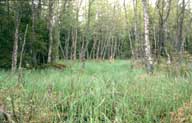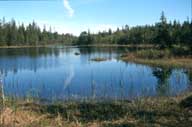The Holmöarna islands
The Holmöarna are a large group of islands in western
Kvarken. Four main islands, each with its own personality, stretch
out across the 26 kilometres from Trappudden in the north to the
lighthouse on Holmögadd to the south. The cluster of islands
is made up of the geological formations drumlins and end moraines
(de Geer moraines). There are few higher points.
The Holmöarna have long been inhabited. Back in the
Iron Age and the early Middle Ages the islands were an important
site for hunting and fishing. The first recorded information about
permanent farmers on Holmön island is from 1543; today, about
90 people are permanent residents of Holmön.
Visitors usually arrive on the Holmöarna at the ferry
dock in Byviken on the main island of the group, Holmön,
which is the northern most island. Byviken has some service buildings;
the village sprawls almost 3 kilometres to the south along the
small village road toward the next island, Ängesön.
Places worth seeing on the main island Holmön include Trappudden
with cliffs and rock rubble fields at the north end and the shingled
lighthouse on Bergudden to the west. North of Bergudden is the
Kammen area, Holmön's biggest rock rubble field. Bergudden
is also usually a good place to observe birds migrating through
western Kvarken.
Like the entire Holmö archipelago, most of Holmön
is dominated by spruce forests on level ground affected by the
uplift, but Holmö village is the big exception. Small-scale
old farming continues in some areas. As you stroll down the road
past the old hayfields around the farms you will see some species
typical of old agricultural areas, like matgrass (Nardus
stricta) and common bent (Agrostis capillaris).
You will also find more unusual species, such as alpine cinquefoil
(Potentilla) and downy alpine oatgrass
(Avenula pubescens). Holmö village,
with its patchwork countryside of tilled fields, small strips
of forest, rock walls, piles of rock cleared from the fields and
shrubbery, is an excellent environment for birds where eastern
species such as the greenish warbler (Phylloscopus
trochiloides), Blyth's reed warbler (Acrocephalus
dumetorum) and red-breasted flycatcher (Ficedula
parva) appear regulary.
Ängesön, south of Holmön, is the other
large island in the group. Other than a couple of isolated vacation
homes, you will not find any built-up area, but it is easy to
get here on the little road that crosses the entire island and
ends at Ängesön's southern tip. Ängesön and
Holmön are separated by the narrow Gebäckssundet, a
passage which despite the land uplift and diminishing water level
is kept open for navigation by small craft. The east side of Ängesön
and Holmön features an extremely diversified topography with
points, inlets and small islets. Inside the coast are hundreds
of small remote former bays that have been cut off from the sea,
ponds, marshes and old peatlands no longer in use, which together
form a confusing landscape. For an easier hike, just follow the
trail along the west side of Ängesön. You can combine
your hike with an overnight stay at the fishing sauna at Sikskärsgrundet
(the key is available at the boat museum on Holmön, (090)
552 20). There are also links from the road at Ängesön
to two excellent picnic areas with wind shelters at Klintviken
and Kontviken. Klintviken is also a nice bay where pleasure craft
often drop anchor.
The southern and south-eastern parts of Ängesön
feature coastal deciduous forests of birch, which contribute to
Ängesön's unique personality. The interior of Ängesön
also has quite a few flat rock forests in the otherwise predominantly
spruce forests.
Grossgrundet is the next island on the journey to the
south in the large Holmö archipelago. This island is almost
5 kilometres long, and is broken up by bays and a few large lakes.
In addition to a few spruce forests on the oldest portions of
the island, Grossgrundet has open heaths with crowberry and juniper
bushes. People rarely visit Grossgrundet since there is no way
to get there, nor are there any facilities for visitors.
Holmögadd, the most southern island in the Holmö
archipelago, is the least known to the public. Holmögadd
has an old stone lighthouse which is mentioned on the Swedish
marine weather forecast daily. The island is a military area and
is completely closed to civilian visitors. The unique nature on
Holmögadd features open heaths and birch forests. The sound
between Grossgrundet and Holmögadd is called Gaddströmmen
and provides excellent fishing, including large grayling in late
winter and early spring.
The very first lighthouse in western Kvarken was built
in 1760 on Holmögadd, a location which has probably always
been known for its dangerous waters. The lighthouse was a coal-burning
"vippfyr" with a rocker arm. At first the lighthouse
was only staffed during the fall.
The Holmöarna nature reserve encompasses an extremely
large area, including all of Holmögadd and Grossgrundet,
most of Ängesön and the eastern side of Holmön.
The forests and beaches develop naturally because of the protection
provided to them as part of a nature reserve.
The nature reserve also includes the island Stora Fjäderägg,
which is also part of in the Holmö archipelago. Stora
Fjäderägg has its own page in the Kvarken Nature
Guide.
|











